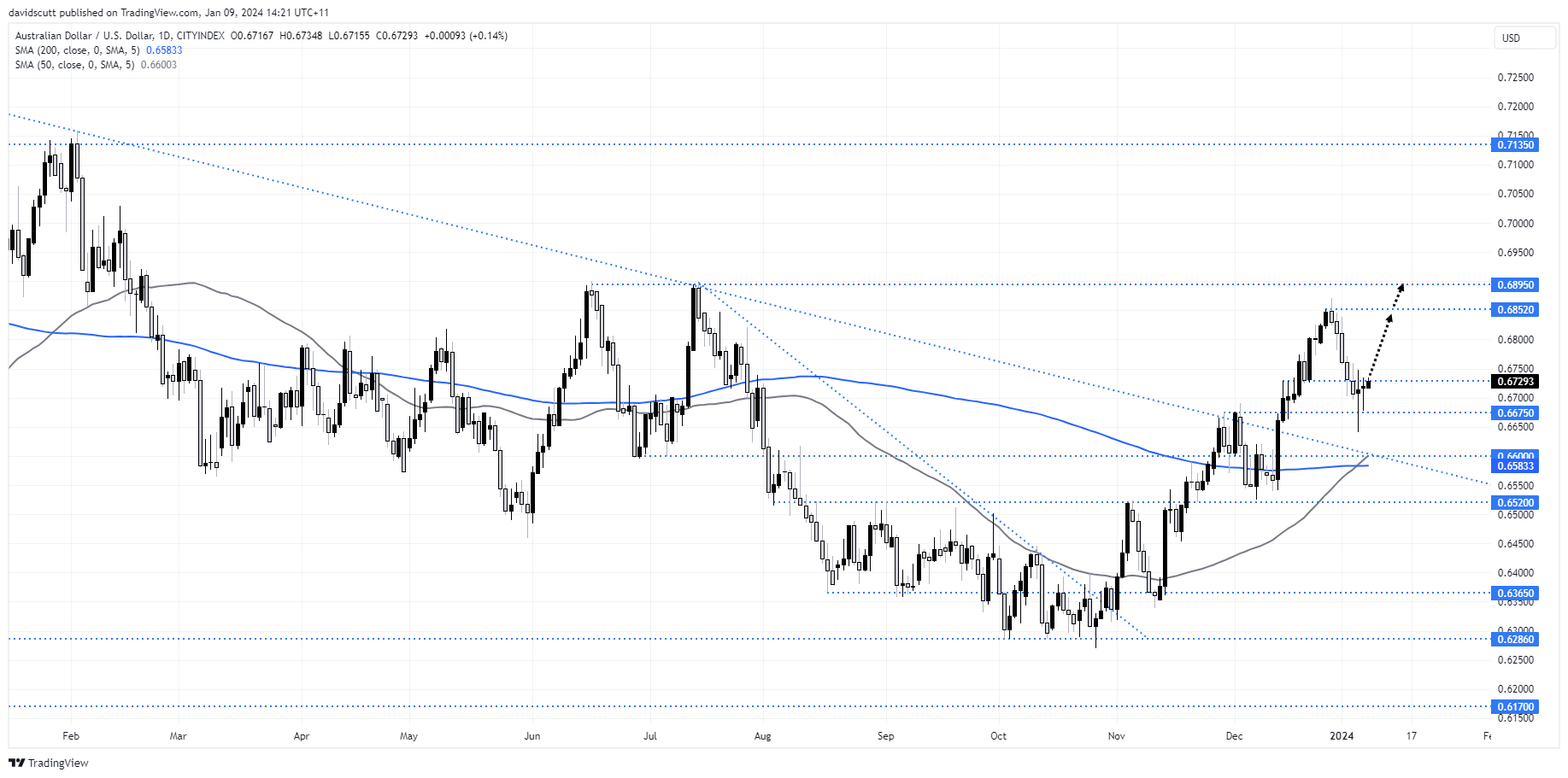
- Australia’s inflation indicator for November will contain fresh information on the stickiness in services prices
- The RBA has previously acknowledged much of Australia’s inflation problem is “home grown”
- US CPI will be released later this week and will likely add to the disinflation narrative
- Weaker US inflation prints have often sparked large gains in riskier asset classes over the past two months.
AUD/USD continues to act as a barometer for sentiment on the prospects for a soft economic landing, ignoring domestic data such as retail sales and building approvals figures released on Tuesday. But the Aussie’s global focus may pause temporarily later this week when Australia’s monthly inflation indicator is released, containing a whole raft of new information on what’s happening with prices at the consumer level, especially for services.
Given the risk services inflation remains sticky as seen in other advanced economies, and the proximity of the latest consumer price inflation report from the United States on Thursday which is likely to show ongoing progress in returning underlying inflation towards the Fed’s 2% target, the prospects for the soft landing narrative may brighten in the days ahead. If correct, it will generate an environment that would normally generate AUD/USD upside.
Services inflation remains a problem for RBA
Services prices, like many parts of the developed world, remains a sticking point for the RBA on its quest to return underlying inflation back to 2.5%, the midpoint of the bank’s 2-3% target. With wage pressures heating up thanks to tightness in the labour market and the government’s industrial relations agenda, it is combining with weak productivity to boost prices for both discretionary and essential services. Given they account for most of the ABS consumer price inflation basket, this has contributed to slow progress in returning inflation to acceptable levels.
The RBA is concerned high inflation expectations may become entrenched among workers and employers, warning of the risk on several occasions in the policy statement from December.
“Underlying inflation was higher than expected at the time of the August forecasts, including across a broad range of services,” Governor Michele Bullock said, adding that if “high inflation were to become entrenched in people’s expectations, it would be much more costly to reduce later, involving even higher interest rates and a larger rise in unemployment.”
“To date, medium-term inflation expectations have been consistent with the inflation target and it is important that this remains the case,” she said.
In a nod to the relative importance of Wednesday’s inflation indicator, she noted that while there have been “encouraging signs on goods inflation abroad, services price inflation has remained persistent and the same could occur in Australia.”
Reduced RBA rate cut bets may boost AUD/USD
Given the November report will contain information on around 70% of services prices in the more comprehensive quarterly update, it will provide a much clearer picture on whether progress in returning inflation to the top of its target band by the middle of next year is likely. While the RBA is unlikely to hike rates again unless underlying inflation remains stubbornly high, ongoing stickiness in services inflation may scupper growing bets the RBA will be forced to begin cutting rates in the second half of 2024.
While no one disputes that at the per capita level Australian household demand is tepid, with population growing by a whopping 624,100 in the year to June, aggregate demand continued to outstrip supply in several key areas, resulting in persistent price pressures. This may be evident in the inflation indicator, potentially unwinding rate cut bets which could support the AUD/USD.
Markets are cherry-picking data to bolster Fed rate cut bets
Another factor that may assist AUD/USD upside is the markets refusal to let go of the soft landing narrative, often resulting in obscure data points generating significant risk on behaviour should they fit with the broader message. Just look at the reaction to the latest New York Fed consumer inflation expectations report, contributing to a renewed bid in riskier asset classes on Monday as bond yields plunged. Outside economic boffins, few would have known of its existence up until recently. Yet its message was exactly what was needed to bring the focus back to rate cuts. Whooshka, up risk assets went.
While it’s not the Fed’s favoured measure, the CPI report may amplify the narrative with a 0.4% increase in December 2022 rolling off the underlying series, generating a lower year-on-year rate unless replaced with a similarly sized increase. With markets looking for only a 0.3% increase, the annual rate is seen sliding to 3.8% from 4%.
Even though a 0.3% increase doesn’t bring inflation anywhere near target when annualised, it’s unlikely to interfere with the disinflation message, for now. If the print comes inline or below market consensus, it may lead to further USD selling across a basket of major currencies, especially those closely aligned with the prospects for global growth and risk appetite such as the Australian dollar.
AUD/USD upside risks brewing?
Having pulled back from multi-month highs in early January on concerns optimism surrounding a soft landing had run far too hard too fast, AUD/USD has stabilised on the daily chart in recent sessions, logging some inconclusive Doji’s before pushing higher to test minor resistance located at .6730 on Tuesday.
For those considering a long trade now, stops could be placed either below .6700 or .6675. For those wanting a better setup, a break above .6730 could allow for a tight stop to be set below, improving the overall risk-reward of the trade. As for upside targets, the pair was rejected twice above .6850 in late December. Above that, .6895 and .7135 are the levels to watch.

-- Written by David Scutt
Follow David on Twitter @scutty
How to trade with City Index
You can trade with City Index by following these four easy steps:
-
Open an account, or log in if you’re already a customer
• Open an account in the UK
• Open an account in Australia
• Open an account in Singapore
- Search for the market you want to trade in our award-winning platform
- Choose your position and size, and your stop and limit levels
- Place the trade










